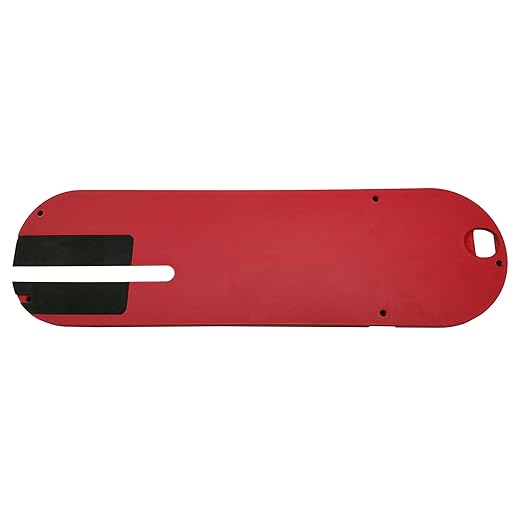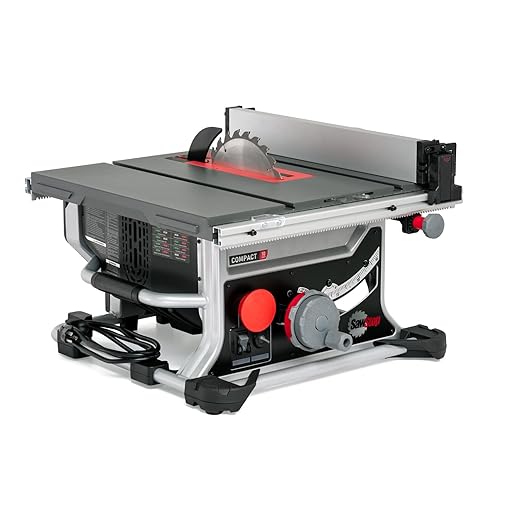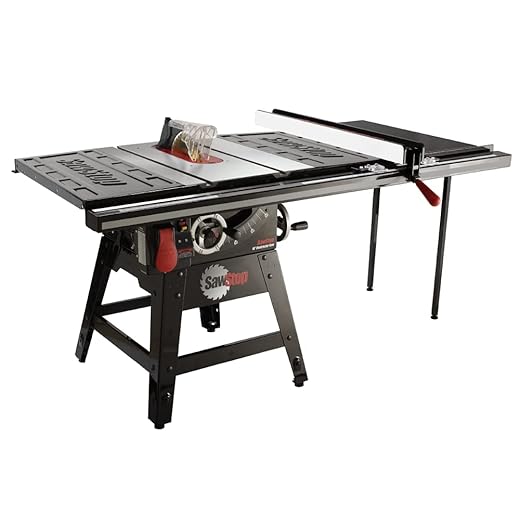SawStop table saws are renowned for their innovative safety features that aim to prevent severe injuries during woodworking. They are equipped with a unique technology that can detect contact between a conductive material, like flesh, and the spinning saw blade. When contact is detected, the SawStop system triggers a rapid braking mechanism that stops the blade’s rotation within milliseconds, minimizing the potential for life-altering accidents.
These table saws are known for their high-quality construction and durability, making them suitable for both professional and hobbyist woodworkers. They offer a range of models to accommodate different project sizes and requirements. Along with their safety features, SawStop table saws also provide precision cutting capabilities, accurate fence adjustments, and other features that contribute to the overall woodworking experience.
SawStop table saws have gained recognition and widespread adoption within the woodworking community due to their commitment to safety and their ability to prevent catastrophic injuries. They continue to be a trusted choice for woodworkers who prioritize safety without compromising on performance and reliability.
Where is SawStop table saw made?
SawStop table saws are manufactured in the United States. The company, SawStop LLC, is headquartered in Tualatin, Oregon. It was founded by Stephen Gass, who invented the SawStop safety system. The company’s manufacturing facilities are located in the United States, where they produce their range of table saws and other woodworking machinery.
SawStop takes pride in its commitment to quality and craftsmanship. By manufacturing their table saws domestically, they can maintain control over the production process, ensuring high standards of quality, safety, and performance. Additionally, being based in the United States allows SawStop to provide responsive customer support and service to their customers.
What is the #1 danger when using a table saw?
The #1 danger when using a table saw is the risk of severe injuries caused by contact with the spinning saw blade. Table saw accidents can result in catastrophic injuries, including deep cuts, amputations, and other life-altering consequences. The combination of the high-speed rotating blade and the power of the motor makes the table saw a potentially hazardous tool if not used properly or with adequate safety precautions.
Contact with the blade can occur due to various reasons, such as kickback (when the workpiece is forcefully propelled back toward the user), improper handling or feeding of the material, lack of proper safety devices or guards, or user error.
To mitigate the risks associated with table saw use, it is crucial to prioritize safety and follow recommended safety practices. This includes wearing appropriate personal protective equipment (PPE), using blade guards and other safety devices, using push sticks or blocks to maintain distance from the blade, and ensuring proper training and understanding of the table saw’s operation.
While innovations like the SawStop safety system have significantly reduced the severity of injuries associated with table saw accidents, it is still essential to maintain vigilance and adhere to safe operating practices to prevent accidents and ensure a safe working environment.
How does sawstop table saw work?
SawStop table saws work by incorporating a unique safety system that can detect contact between a conductive material, such as flesh, and the spinning saw blade. Here’s a simplified explanation of how SawStop table saws operate:
- Capacitive Sensing: SawStop table saws use capacitive sensing technology. They generate a low-level electrical signal and create an electric field around the saw blade.
- Contact Detection: When a conductive material, like a finger, comes into contact with the spinning blade, the electrical capacitance of the system changes. This change is detected by the capacitive sensing technology.
- Activation Signal: Once contact with a conductive material is detected, the SawStop system triggers an activation signal.
- Braking Mechanism Engagement: The activation signal activates the braking mechanism, which consists of an aluminum brake pawl and a spring-loaded activation cartridge. The activation cartridge releases the brake pawl, driving it into the teeth of the spinning blade.
- Blade Stoppage: As the brake pawl makes contact with the blade’s teeth, it exerts significant force, bringing the blade to a complete stop within milliseconds. This immediate stopping action helps prevent further contact and reduces the severity of potential injuries.
It’s important to note that once the SawStop system is activated, the blade, the aluminum brake pawl, and other components are damaged and need to be replaced to restore the table saw’s safety features.
SawStop table saws are designed to prioritize user safety by quickly stopping the blade in case of accidental contact, potentially preventing severe injuries. This unique safety system has made SawStop table saws highly regarded and widely used among woodworking professionals and enthusiasts.
What should you never cut on a SawStop table saw?
While SawStop table saws are designed to handle a wide range of wood and wood-based materials, there are certain materials that are not suitable for cutting on a SawStop table saw. Here are a few examples of materials you should avoid cutting on a SawStop table saw:
- Non-Conductive Materials: SawStop relies on the detection of electrical capacitance changes to trigger the braking mechanism. Materials that are non-conductive or have very low conductivity may not be recognized by the system. Examples of non-conductive materials include plastics, glass, stone, ceramics, and non-ferrous metals like aluminum or copper.
- Wet or Damp Materials: Cutting wet or damp materials, regardless of their conductivity, is generally not recommended on any table saw, including SawStop. Wet wood or other materials can affect the performance of the blade, increase the risk of kickback, and potentially compromise safety.
- Excessively Thick or Hard Materials: SawStop table saws are designed for cutting wood and wood-based materials of typical thicknesses encountered in woodworking projects. Excessively thick or extremely hard materials, such as dense hardwoods or metals, may put excessive strain on the saw’s motor, blade, and braking mechanism, potentially leading to reduced performance or damage.
It’s important to refer to the manufacturer’s guidelines and recommendations provided with your specific SawStop table saw to determine the appropriate materials for cutting. If you have materials or projects that deviate from typical woodworking applications, it’s advisable to consult the manufacturer or seek professional advice to ensure safe and appropriate usage.
Can you cut plastic on a SawStop table saw?
Yes, you can cut certain types of plastic on a SawStop table saw. While SawStop table saws are primarily designed for cutting wood and wood-based materials, they can handle some types of plastic as well. However, it’s important to note that not all plastics are suitable for cutting on a table saw, and the appropriateness depends on the specific type and characteristics of the plastic.
When cutting plastic on a SawStop table saw, consider the following:
- Plastic Type: Ensure that the plastic you intend to cut is compatible with the table saw. Certain plastics, such as high-density polyethylene (HDPE), acrylic, and polycarbonate, are commonly cut on table saws. Softer plastics, such as PVC, may also be suitable. However, harder or brittle plastics may pose challenges and increase the risk of chipping, cracking, or other issues.
- Blade Selection: Choose an appropriate blade for cutting plastic. For most plastic materials, a blade with a high tooth count, specifically designed for cutting plastics or non-ferrous metals, is recommended. These blades typically have finer teeth and are designed to minimize chipping and provide clean cuts.
- Feed Rate and Cutting Techniques: Adjust the feed rate and cutting techniques based on the plastic being cut. Plastic materials may require slower feed rates and more controlled cutting techniques compared to wood. It’s important to feed the plastic material steadily and avoid applying excessive force that could lead to binding or other issues.
- Safety Considerations: When cutting plastic or any material on a table saw, it’s crucial to adhere to proper safety practices. Wear appropriate personal protective equipment, such as safety goggles and respiratory protection, and ensure the workpiece is properly secured and supported. Follow all manufacturer’s guidelines and recommendations for safe cutting practices.
It’s important to consult the manufacturer’s guidelines and recommendations for your specific SawStop table saw model regarding cutting plastic or any non-wood materials. Additionally, exercise caution and consider the specific characteristics and requirements of the plastic you intend to cut to ensure a safe and successful cutting experience.
Why not use gloves with table saw?
It is generally not recommended to wear gloves when operating a table saw or any other power tool with rotating blades. Here are the reasons why gloves should be avoided:
- Reduced Dexterity and Control: Wearing gloves can decrease your manual dexterity and tactile sensitivity, making it more difficult to grip and control the workpiece. This can lead to a loss of control over the material being cut, increasing the risk of accidents and potential injuries.
- Increased Risk of Entanglement: Gloves can pose a significant risk of entanglement with the rotating blade. Loose-fitting or baggy gloves can get caught in the blade, pulling your hand towards it and potentially causing severe injuries.
- Decreased Sensitivity to Feedback: The sense of touch is essential for detecting changes in pressure, resistance, or abnormalities while operating a table saw. Gloves can reduce your ability to sense such feedback, making it harder to notice potential issues or hazards during cutting.
- Heat and Moisture Accumulation: When operating a table saw, the blade and motor generate heat. Wearing gloves can trap heat and moisture against your skin, potentially leading to discomfort, sweat accumulation, or reduced grip.
- Interference with Safety Devices: Most table saws are equipped with safety features such as blade guards, splitters, or riving knives. Wearing gloves can interfere with the proper operation of these safety devices, compromising their effectiveness in preventing accidents.
Instead of gloves, it is recommended to focus on using other safety measures when operating a table saw, such as:
- Wearing appropriate personal protective equipment, including safety glasses, hearing protection, and sturdy, non-loose-fitting clothing.
- Using push sticks or push blocks to maintain a safe distance from the blade while feeding the material through the saw.
- Ensuring the table saw is properly maintained and adjusted, with safety devices and guards in place and functioning correctly.
- Following safe cutting techniques and guidelines provided by the manufacturer, including proper feeding and support of the workpiece.
By prioritizing proper safety practices and avoiding gloves, you can help reduce the risk of accidents and maintain better control and awareness while operating a table saw.
Factors to consider when buying sawstop table saw?
When buying a SawStop table saw, there are several factors to consider to ensure that you select the right model that meets your needs and requirements. Here are some key factors to consider:
- Safety Features: SawStop table saws are renowned for their safety features. However, it’s important to assess the specific safety features offered by the model you are considering. Look for features like blade guards, emergency stop buttons, and additional safety mechanisms that align with your safety priorities.
- Budget: Determine your budget range and explore the SawStop models available within that range. SawStop table saws generally come at a higher price point compared to conventional table saws due to their advanced safety technology. Consider the added value of enhanced safety features when assessing the cost.
- Table Size and Power: Consider the size of the table and the power of the motor. The table size should be suitable for the projects you work on and provide adequate space for handling larger workpieces. The power of the motor should match your cutting needs, considering the type and thickness of materials you typically work with.
- Precision and Accuracy: Assess the accuracy and precision of the table saw’s cutting capabilities. Look for features like a reliable fence system, stable miter gauge, and the ability to make fine adjustments to the blade height and angle. These factors contribute to achieving accurate and clean cuts.
- Build Quality and Durability: Evaluate the overall build quality and durability of the table saw. Look for sturdy construction, quality materials, and components that can withstand heavy use over time. A durable table saw will provide longevity and reliability in your woodworking projects.
- Additional Features and Accessories: Consider any additional features and accessories that may enhance your woodworking experience. This can include features like dust collection systems, mobile bases for portability, extension tables, and compatibility with various blades and attachments.
- User Reviews and Feedback: Read user reviews and seek feedback from other woodworkers who have experience with the specific SawStop model you are considering. Real-world experiences can provide valuable insights into the performance, reliability, and overall satisfaction with the table saw.
By considering these factors, you can narrow down your options and choose the SawStop table saw that best aligns with your safety requirements, budget, woodworking needs, and desired features.
Should you buy sawstop table saw?
Deciding whether to buy a SawStop table saw depends on your individual circumstances, priorities, and woodworking needs. Here are some points to consider when making your decision:
- Safety Priority: If safety is your top priority and you want an added layer of protection against severe injuries caused by table saw accidents, investing in a SawStop table saw may be a wise choice. The SawStop technology is specifically designed to detect contact with flesh and rapidly stop the blade, potentially preventing life-altering accidents.
- Risk Assessment: Assess the nature of your woodworking projects, your level of experience, and the potential risks involved. If you frequently work with power tools, especially table saws, and handle larger or more complex projects, the risk of accidents may be higher. In such cases, having a table saw with enhanced safety features like SawStop can be beneficial in mitigating potential risks.
- Regulatory or Insurance Requirements: In some professional settings or educational institutions, there may be specific safety regulations or insurance requirements that mandate the use of table saws equipped with advanced safety features like SawStop. If you fall under such requirements, purchasing a SawStop table saw may be necessary to comply with regulations and ensure a safe working environment.
- Budget: Consider your budget when evaluating whether to purchase a SawStop table saw. SawStop table saws generally come at a higher price point compared to conventional table saws due to the advanced safety technology. Assess the value of the enhanced safety features and determine if the added cost aligns with your budget and safety priorities.
- Alternative Safety Measures: It’s important to note that there are other safety measures you can implement, such as using blade guards, push sticks, and practicing safe cutting techniques, to reduce the risk of accidents on a conventional table saw. While these measures do not offer the same automatic blade-stopping capability as SawStop, they can still contribute to a safer working environment.
Ultimately, the decision to buy a SawStop table saw should be based on your personal circumstances, priorities, and risk assessment. If safety is a paramount concern for you and you have the budget to accommodate the higher cost, a SawStop table saw can provide peace of mind and an additional layer of safety in your woodworking endeavors.
You May Also Like These Deals!
Is a SawStop worth the price?
SawStop is a pioneering technology in the field of power...
Read MoreBest Miter Saw Black Friday Deals
Many people’s first woodworking machine purchase is a miter saw,...
Read MoreBest Table Saw Black Friday Deals
Table saws can be used for a variety of professional...
Read MoreBest Chainsaw Black Friday Deals
If you’re in the market for a new chainsaw, then...
Read MoreProducts recommended in the post contain affiliate links. We may receive a commission when you buy something through our posts.
Why Trust Us
You will find what you are looking for at Black Friday Weeks. From classic to luxury brands, you'll find both. We will help you to select appliances that fit your needs, budget and lifestyle. Whether you want to stop by to learn more — or plan to make a major purchase — we’ll treat you like family and assist you every step of the way. Shop with us today to receive friendly and experienced help along the way.















